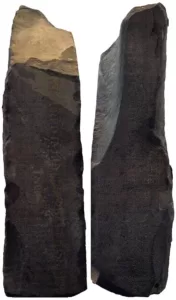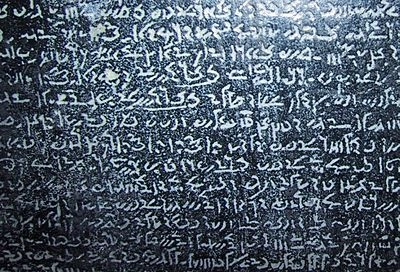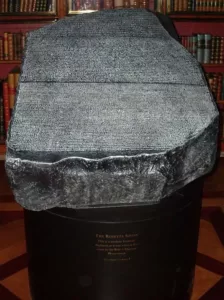In the annals of history, there are moments when a single discovery alters the course of human understanding forever. Two hundred years ago, a 31-year-old Frenchman named Jean-François Champollion made an emphatic declaration. In his brother’s Paris office on September 14, 1822, he declared—”Je tiens mon affaire!” (“I’ve got it!”). What was this momentous breakthrough, and why did it leave Champollion and the world in awe? – The Ancient Egyptian Rosetta
This Ancient Stone was an extraordinary discovery during Napoleon Bonaparte’s Egyptian campaign in 1799.
It was a black basalt slab featuring inscriptions in Greek, Demotic, and hieroglyphics. It played a pivotal role in unravelling the mysteries of hieroglyphics, a script that had baffled scholars for centuries.
In this blog post, we’ll delve into the captivating story of the Ancient Egyptian rosetta stone. It is an unassuming slab of granodiorite that holds the key to the unlocked history of ancient Egypt. You may also interested in my article about Egyptian attendance sheet.
The Rosetta Stone: A Key to Ancient Egypt
The Rosetta Stone is a fragment of a larger slab erected at an Egyptian temple in 196 B.C.E. during the reign of Ptolemy V. He was a Ptolemaic king of Macedonian-Greek ancestry. This unassuming slab of granodiorite holds inscriptions in three scripts:
- Hieroglyphs
- Demotic (a shorthand form of hieroglyphs)
- Ancient Greek

It was this trilingual nature that made it the Egyptian Rosetta Stone, named after the town where it was found. The hieroglyphic script, in particular, has long intrigued scholars and laypeople alike. Developed around 3100 B.C.E., hieroglyphs are pictorial symbols used to write the ancient Egyptian language.
By Ptolemy’s time, hieroglyphs had been in use for over 3,000 years, mainly by priests. While the general public favored the simpler Demotic script. This ancient script, and the civilization it represented, had thrived for millennia. The Rosetta Stone offered the hope of unlocking its secrets.
The Challenge of Decipherment
The expectation was that deciphering the Rosetta Stone would be a straightforward task. It was believed that scholars of the time could use the Greek inscriptions as a key to unlock the hieroglyphic script.
One significant obstacle was the complexity of hieroglyphs. These symbols were not just a form of writing. They were rich in meaning and often presented a fusion of phonetic, pictographic, and ideographic elements. This made them enigmatic, akin to solving a puzzle where each symbol could represent a sound, an object, or an idea.
Moreover, the Rosetta Stone was more than just a bilingual text; it was trilingual. The differences in the scripts and the content of the inscriptions created further complexity, leaving early attempts at decipherment in shambles.
The Rivalry: Champollion vs. Young

As the scholarly world grappled with the Rosetta Stone, two figures emerged as the frontrunners in the quest for decipherment:
- Jean-François Champollion
- Thomas Young
Their rivalry was heightened by the geopolitical backdrop of France and England being great rivals at the time.
Young made an initial breakthrough by focusing on hieroglyphs enclosed in oval frames, known as cartouches. He proposed that hieroglyphs could be phonetic, especially when used to write foreign names that had similar pronunciations across languages. However, Young’s progress stalled as he hesitated to embrace the idea that hieroglyphs could represent sounds.
Champollion’s Triumph
Champollion, in contrast, was unrelenting in his quest to understand hieroglyphs and the ancient Egyptian culture. He combined his knowledge of Coptic, a language derived from ancient Egyptian, with Young’s insights to finally crack the code.

Champollion compared hieroglyphs with the Greek translation of the Egyptian Rosetta Stone. He identified phonetic values for hieroglyphs and translated additional cartouches. His pivotal moment came when he deciphered the cartouche for Ramses, a name of Egyptian origin. This breakthrough confirmed that hieroglyphs were indeed phonetic, and he unravelled the underlying Egyptian language.
Controversies and Calls for Repatriation
The Rosetta Stone continues to captivate visitors at the British Museum. But its presence has not been without controversy.

The ownership of the Rosetta Stone has been a contentious issue for many years. Critics argue that this ancient stone artifact, rightfully belongs within the borders of the country from which it originated. The stone’s removal from Egypt during the colonial era, marked with inscriptions like:
“Captured in Egypt by the British Army 1801”
“Presented by King George III,”
has fueled claims that it was acquired under conditions that are now viewed as ethically questionable.
These controversies have led to ongoing discussions between Egypt and the British Museum regarding the Rosetta Stone’s future. Calls for repatriation to Egypt, where it could serve as a symbol of national heritage and a testament to Egypt’s rich history, persist.
Legacy of the Rosetta Stone
Two hundred years later, the Egypt Rosetta Stone remains an iconic artifact that has left an indelible mark on ancient Egypt. This remarkable artifact was discovered in the town of Rosetta, Egypt. It is one of the most popular attractions at the British Museum. It serves as a testament to human curiosity and the relentless pursuit of knowledge.
The Rosetta Stone’s legacy extends beyond its physical presence. It opened the door to the rich history and culture of ancient Egypt, allowing us to hear their voices and understand their civilization. I also covered Egyptian pillows made by stone, don’t miss out this fascinating information that has a history of being used with Egyptian mummies and tombs.
In conclusion, the Rosetta Stone is not just a relic of the past; it is a timeless testament to the human spirit’s unquenchable thirst for knowledge. It stands as a monument to the ability of dedicated individuals to unlock the mysteries of history.
FAQs
What was written on the Rosetta Stone?
The Rosetta Stone features a decree issued by Egyptian priests during the reign of Ptolemy V. It contains versions of the decree in three scripts: hieroglyphs, Demotic, and ancient Greek.
How did historians manage to decode the Rosetta Stone?
Historians decoded the ancient Stone by comparing the inscriptions in hieroglyphs with the Greek translation on the stone. This comparison allowed them to determine the phonetic values of hieroglyphs and unlock the ancient Egyptian language.
How was the Rosetta Stone key to the legacy of ancient Egypt?
The Rosetta Stone played a pivotal role in unravelling the mysteries of ancient Egypt. Its decipherment provided access to the rich history and culture of this civilization, allowing us to understand its legacy.
What did scholars study to help them decipher hieroglyphics?
Scholars studied various elements, including the:
- Greek inscription on the Rosetta Stone
- Context of the hieroglyphic texts
- Their knowledge of languages like Coptic derived from ancient Egyptian
Which best describes the author’s viewpoint toward the actual Rosetta Stone in “The Rosetta Stone”?
The author’s viewpoint toward the actual Rosetta Stone is one of deep admiration and recognition of its historical and cultural significance. The stone is portrayed as a key to unlocking the secrets of ancient Egypt.

